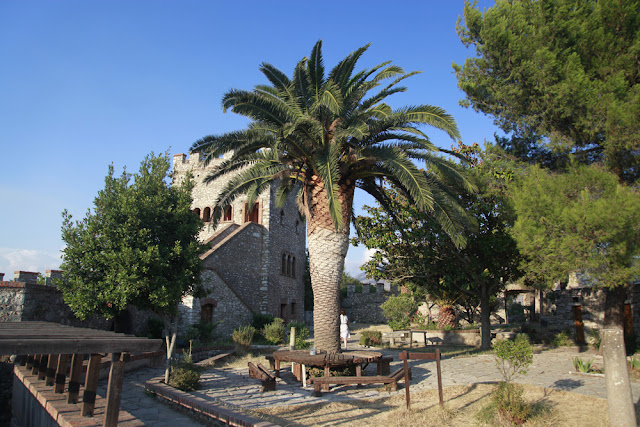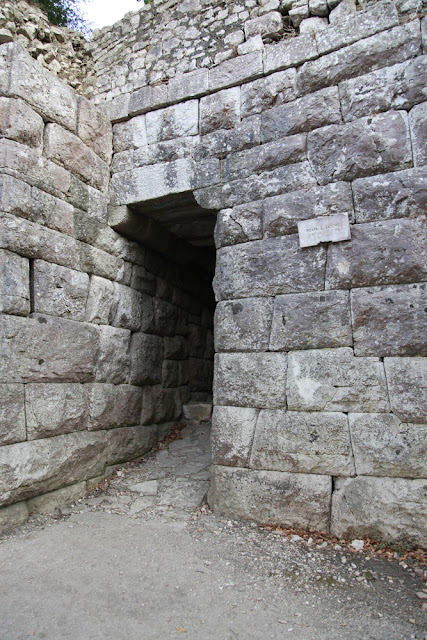Goodness, what a ride!
Albanian shore has brilliant views, but no roads to reach them. I know, I already said that a hundred times, but I'm still wondering about their completely broken roads. For the justice's sake, I should say that all the roads to the country border are good, safe and sound. Fresh asphalt, like a smooth and plain ribbon, flowing through the mountains.
But, inside the country, it's a tragedy. For the car and for your back. My back, actually...
In Vlore we woke up and decided to check out, despite the fact that we had 2 night booked in that hotel. Thanks God we realized it's impossible to come back from Sarande with those roads, even if the next city was only 120 kilometers away. We crossed the mountain on a very high road, at about 1500 meters, and went on the shore, on a hidden beach we spotted from the top.
The water was warm and cristal clear and the view absolutely astonishing!
So, we fooled around a little bit... sorry, no pictures available. :)
We had to cross a stone quarry in order to get on that desert beach... it was beautiful.
Lunch and some beer in Himara, a small and pretty resort in a quiet gulf... Shrimps, mussels and octopus, if you're wondering...
Ruins and castles all over the place, we really didn't know where to go first!
And suddenly, we knew! The last destination in Albania: Butrint.
The ancient name is Buthrotum, a port from Hellenistic to Ottoman times, is a UNESCO World Heritage Site in south-west Albania, only few kilometers to the Greek border. Situated on the Straits of Corfu, and surrounded by a picturesque lagoon, it is one of the most remarkable archaeological sites in the Adriatic Sea region.
Following twelve years of archaeological excavations and major investment in site management, the site and its museum make it an exceptionally attractive place to visit.
The Venetian Republic purchased Butrint, with the island of Corfu, in 1386 from the Angevins Kings of southern Italy. The main importance of Butrint for the Venetians was the strategic advantage of having an outpost on the mainland and the financial value of the fisheries in Lake Butrint.
After the fall of the Venetian republic in 1797, and the French occupation of the Ionian Islands, Butrint was occupied by Ali Pasha of Tepelena, marking the end of the Venetian presence on the mainland.
However, the antiquarian studies developed through the Renaissance would form a lasting legacy for Butrint, and the site became a key theatre of interest, first for painters, artists and grand tourists, then for archaeologist.
In 1992 Butrint was designated as a World Heritage Site – a status that identifies cultural and natural sites of outstanding universal value.
Butrint, from the 5th century, had a bishop and the Great Basilica was the bishop's church. It was constructed in the early 6th century AD, at the same time as the Baptistery. The original basilica would have had three aisles separated by colonnades of columns and capitals reused from earlier buildings, some of these can still be seen inside. The floor was paved with a mosaic, which was created by the same craftsmen who made the Baptistery mosaic, and there was a polygonal apse.
The city is big and there are plenty of remains, but the Baptistery seems to be one of the most important. The Baptistery was discovered in 1928 by the Italian Archaeological mission. It is the second largest baptistery in the Eastern Roman Empire, the largest being that of Hagia Sofia in Istanbul.
Every aspect of the architecture and decoration of the Baptistery is symbolic of the baptismal rite, with the fountain on the far side of the Baptistery representing the fountain of eternal life. The intricate brightly coloured mosaic has representations of land (animals), air (birds), and water (fish), symbolizing aspects of Christian salvation.
With the eyes glued to the Venetian castle, we crossed the lagoon with an old wooden ferry, drawn by wires... Once in Greece, we hurried up to Thessaloniki, on the highway, after a very long day.




















4 comentarii:
super calatorie, plaja aia chiar daca era cu pietre m-a facut pilaf, superba :)
wow!
arata foarte bine! se pare ca a meritat efortul :)
What an absolutely breathtaking spot. I would never, ever planned a trip to Albania before now! : )
Happy belated Birthday to Bogdan as well!
Hugs
~Andrea
Trimiteți un comentariu